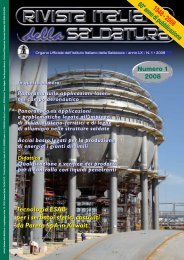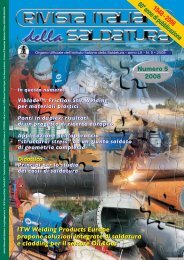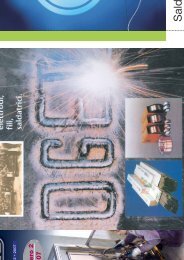You also want an ePaper? Increase the reach of your titles
YUMPU automatically turns print PDFs into web optimized ePapers that Google loves.
E. Seib e M. Koçak - Fracture analysis of strength undermatched welds of thin-walled aluminium structures using FITNET procedure<br />
LBW and FSW of aerospace grade Alalloy<br />
6013 in thin-walled condition has<br />
been demonstrated. It has been shown<br />
that special care should be exercised in<br />
selecting the material input parameters<br />
and the assumption on the stress state of<br />
the panels.<br />
6. Conclusions<br />
The application of the mismatch option<br />
of the Fracture Module of the FITNET<br />
FFS Procedure to LBW and FSW panels<br />
has yielded conservative estimations of<br />
the maximum load carrying capacity.<br />
This analysis option allows for the<br />
account of weld specific features like the<br />
local tensile properties of the weld material<br />
as well as the weld geometry by<br />
including the weld width, 2H, in the<br />
yield load solution of the strength<br />
mismatched configuration.<br />
The verification of the FITNET FFS<br />
Procedure for highly strength undermatched<br />
Al-alloy welds in thin-walled<br />
structures under tension yielded the<br />
following results:<br />
• The variation of selected input<br />
parameters has shown that the<br />
residual strength predictions are less<br />
sensitive to the weld width, 2H, and<br />
the weld metal strain hardening exponent,<br />
N W.<br />
• The variation of the weld metal yield<br />
strength, σ YW, however, has significantly<br />
affected the residual strength<br />
predictions of the welded panels. It is<br />
therefore recommended to determine<br />
and use local tensile properties of the<br />
weld material with micro-flat tensile<br />
specimens.<br />
• This technique provides intrinsic<br />
(local) stress-strain curves of the<br />
material region of interest. Global<br />
tensile properties of the weld joints,<br />
as they are obtained from standard<br />
transverse flat tensile specimens, may<br />
over-estimate the weld metal yield<br />
strength, which in turn may lead to<br />
non-conservative residual strength<br />
predictions of structural components<br />
containing cracks in such strength<br />
undermatched welds.<br />
• The variation of the constraint parameter<br />
m has shown that the value of<br />
m = 2.0 is suitable for highly undermatched<br />
LBW and FSW panels to<br />
predict the maximum load and<br />
References<br />
[1] Rendings K.H.: «Aluminium structures used in aerospace - Status and<br />
Prospects», Materials Science Forum, 1997, 242, pp. 11-24.<br />
[2] Irving B.: «Why aren’t airplanes welded», Welding Journal, 1997, 76, (1),<br />
pp. 31-42.<br />
[3] FITNET, European Fitness-for-Service (FFS) Network. GIRT-CT-2001-<br />
05071, http://www.eurofitnet.org.<br />
[4] ARAMIS: «Optical deformation analysis», http://www.gom.com.<br />
[5] Miller A.G.: «Review of limit loads of structures containing defects», International<br />
Journal of Pressure Vessels and Piping, 1988, 32, pp. 197-327.<br />
[6] Schwalbe K.H., Kim Y.J., Hao S., Cornec A., Koçak M.: «EFAM ETM-MM<br />
96: The ETM method for assessing the significance of crack-like defects in<br />
joints with mechanical heterogeneity (strength mismatch)», GKSS Report<br />
97/E/9, GKSS Forschungszentrum, 1997.<br />
[7] Koçak M.: «Fitness for service analysis of structures using FITNET procedure:<br />
an overview». In: Proceedings of the 24th International Conference on<br />
Offshore Mechanics and Arctic Engineering (OMAE)», Halkidiki, Greece,<br />
12-17 June, 2005.<br />
[8] SINTAP: Structural INTegrity Assessment Procedure, final revision.<br />
EU-Project BE 95-1462 Brite Euram Programme, 1999.<br />
[9] Seib E.: «Residual strength analysis of laser beam and friction stir welded<br />
aluminium panels for aerospace applications», PhD thesis (2005), TU<br />
Hamburg-Hamburg. To be published.<br />
➠ segue<br />
Sommario<br />
Analisi della frattura di saldature di componenti sottili in alluminio<br />
significativamente undermatched utilizzando la procedura FITNET<br />
L’articolo presenta una metodologia per la predizione della resistenza residua<br />
in componenti sottili soggetti a carichi con saldature significativamente undermatched<br />
contenenti difetti bidimensionali.<br />
L’analisi è basata sulla Mismatch Option (in termini di resistenza meccanica)<br />
del Modulo Fracture, inserito nella recente procedura FITNET per il Fitness<br />
for Service (FFS) . La Mismatch Option permette di considerare, nell’analisi di<br />
meccanica della frattura di componenti saldati contenenti difetti, caratteristiche<br />
della saldatura, come la resistenza meccanica e la configurazione<br />
geometrica.<br />
La metodologia descritta è stata verificata con i dati sperimentali risultanti da<br />
questo studio.<br />
Il materiale utilizzato è la lega di alluminio 6013 T6 indurita mediante invecchiamento<br />
ultilizzata recentemente in componenti di strutture areonautiche.<br />
Le saldature, testa a testa, sono state eseguite mediante saldatura laser CO 2 e<br />
FSW.<br />
Sono stati analizzati il comportamento della deformazione e della frattura così<br />
come ulteriori particolari caratteristiche secondo i criteri della procedura FFS<br />
FITNET.<br />
I risultati hanno mostrato che usando la metodologia presentata, seguendo le<br />
recenti raccomandazioni proposte per la selezione dei dati d’ingresso, può<br />
essere ottenuta una previsione conservativa della massima capacità di sopportare<br />
il carico di grandi panelli saldati sottoposti a carico di trazione contenenti<br />
lunghe cricche nella saldatura.<br />
Riv. Ital. Saldatura - n. 1 - Gennaio / Febbraio <strong>2007</strong><br />
101





